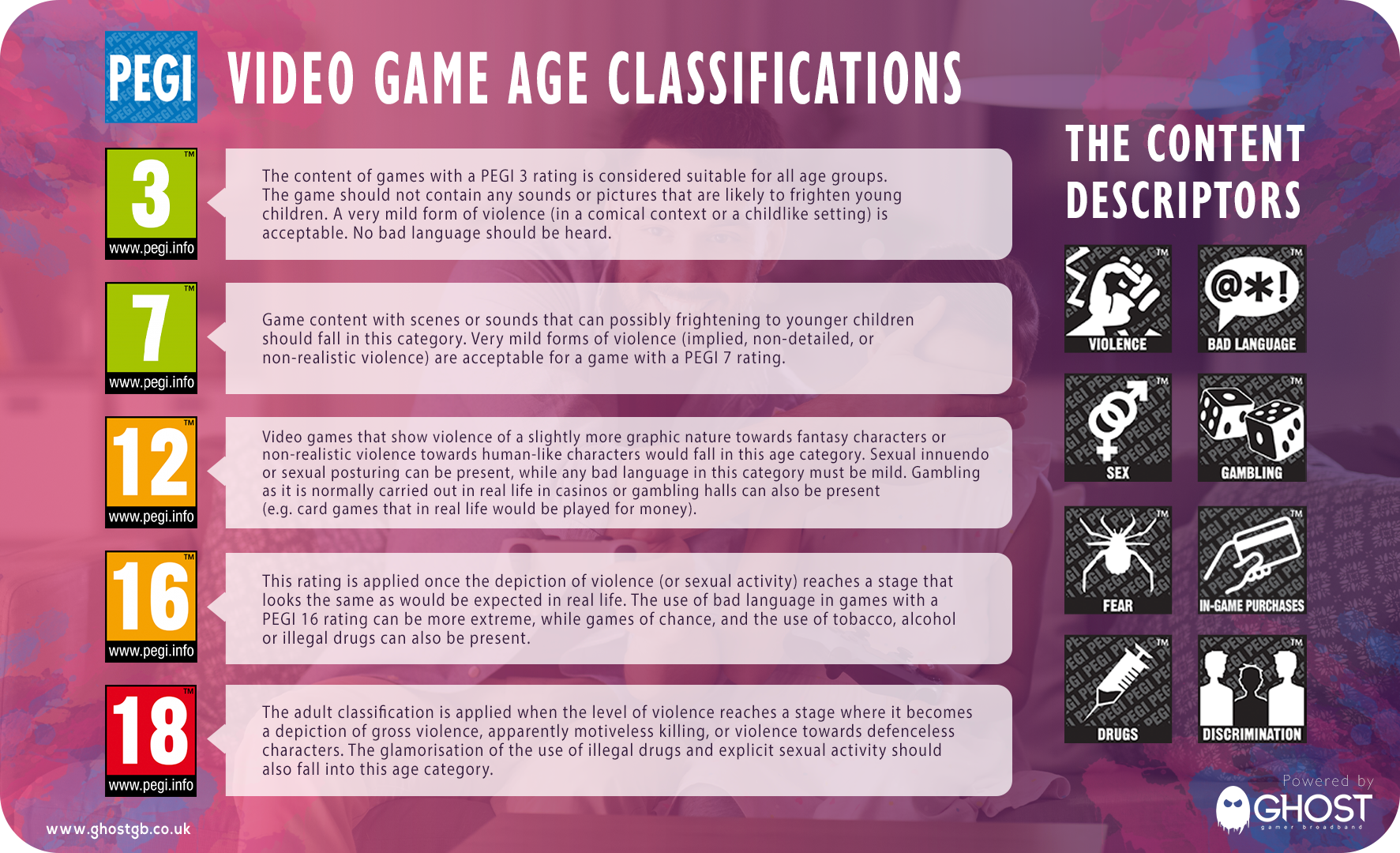The Pan European Game Information (PEGI) age ratings system was made legally enforceable in the UK in 2012. Prior to this the classifications had been provided for advice only, in parallel with film ratings from the British Board of Film Classification (BBFC) which were enforceable.
Since 2012, film certification ratings have disappeared from game marketing and packaging. PEGI ratings are now ubiquitous. It is an offence in the UK to sell a game to a person under the ages of 12, 16 or 18 if a title is PEGI-rated for one of these age groups.

Why games have age ratings
Age ratings exist to protect children or vulnerable people from content deemed harmful, frightening, upsetting or worrying. Their purpose is to help parents and other consumers make informed buying decisions based on a game’s content.
Ratings are also intended to safeguard against the perceived negative influence that interactive entertainment may have on children, who can be more impressionable during the developmental phases of their growth.
Causes for concern
While there is a broad range of potentially objectionable or controversial content, which spans across a spectrum of intensity and acceptability, there are some typical elements which shape the argument for restricted sales.
Simulated realism
As graphics rendering develops, and game engines allow for ever-more lifelike physics and animation, the question of what in-game activities are acceptable continues to evolve.
A recent decision by the developers of Superhot VR to remove depictions of self-harm and suicide from the game highlighted the fact that actions in virtual reality have the potential to be even more disturbing and controversial than those rendered on ‘traditional’ gaming hardware.
Online interactions
Bad or discriminatory language, discussion topics or outright bullying can all occur in a digital space where players communicate with one another. Without in-built oversight or protection, an unregulated, toxic environment can develop.
Gambling
As loot boxes and microtransactions dominate gaming, age ratings have been used to protect children from developing behaviours that may lead to addiction or problem gambling.
Violence
There have been many studies into the effects of violent video games on behaviour. While some seemingly link violent games with short-term increases in aggression or anger, no strong links to long term behavioural issues or criminality have been confirmed.
Rockstar Games’ 2007 survival horror title Manhunt 2 is infamous for being temporarily banned from sale in the UK due to its graphic violence being linked to a real-life murder.
It was suggested the perpetrator was ‘obsessed’ with the game and the killing itself emulated content. However, police later dismissed the link from their investigations.
UK game age ratings explained
While different countries have their own ratings systems, most European countries and the UK follow the PEGI standard.
In the UK, the three enforceable age ratings are:
Rated 12
For non-graphic violence to humans or animals with a higher threshold for violence to fantasy characters, significant nudity, or bad language.
Rated 16
This applies if the depiction of violence or sexual activity looks true to life, or for any references to drugs, alcohol, or tobacco.
Rated 18
This is applied for a ‘gross’ level of violence, motiveless killing or any violence towards defenceless characters.
Glamourisation of drugs, explicit sexual activity and the simulation of gambling also push games to 18.
Younger age ratings
PEGI also include 3+ and 7+ ratings for further parental guidance. However, these are not legally enforceable.
Older games that include gambling can be found with 12 or 16 ratings. Since 2020, any game that simulates or teaches gambling is awarded an 18.

PEGI ratings pictograms
PEGI further break down ratings with pictographs to illustrate content categories. Clear, simple visual indicators are used to communicate content warnings for situations containing fear, violence, drug use and discrimination, to name a few.
Some games receive content warnings for online chat functions or in-game purchases. Online chat can introduce content that is not age-appropriate without warning. Depending on in-built protections, chat functionality may also lack sufficient moderation.
In-game purchases of chance elements, like card packs, carry the phrase ‘Includes Random Items’ in store listings or marketing, due to concerns over the development of addictive behaviours in young people.
Cultural and moral perspectives
There’s a level of subjectivity involved with applying ratings, which carries an implicit sense of morality which may not be universally shared.
For example, bad language acceptable for a 12-rated game can be ‘mild swearing’. However, blasphemy pushes a game to a 16 rating. Yet for non-religious individuals, mild swearing may be more offensive than blasphemy.
Differing national sensibilities can lead to the same title receiving a broad range of ratings across different markets. The Sims 4 was deemed inoffensive enough to be rated only 6+ by the German ratings board USK. Meanwhile, Russian moral attitudes led to the game being rated 18+ for allowing same-sex couples and conflict within families.

Beyond censorship
Surveys of parents in the UK suggest many pay little or no attention to higher age ratings, despite being legally enforceable. The current system is not preventing games being bought by adults for underage gamers.
However, the youngest PEGI age ratings of 3+ and 7+ being for guidance only also shows the importance of context and interpreting what may be best for young minds, rather than simply restricting all games sales.
Taking an interest in what young gamers consume is important. Openly discussing with a child about how they feel when something upsets them can help to process the experience. It may also defuse some of the potential ‘harm’ that sweeping restrictions try (and sometimes fail) to prevent.

